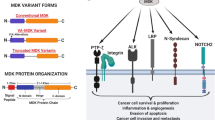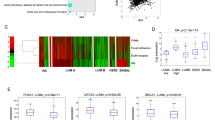Abstract
The importance of the tumor microenvironment in targeted anticancer therapies has been well recognized. Various protein factors participate in the cross-talk between tumor cells and non-malignant cells. Anterior gradient-2 (AGR2) is overexpressed in diverse human adenocarcinomas and it exists in both intracellular and extracellular spaces. Although intracellular AGR2 has been intensively investigated, the function of secreted AGR2, especially its exact mechanism of action is still poorly understood. Here we report that the secreted AGR2 promotes the angiogenesis and the invasion of vascular endothelial cells and fibroblasts by enhancing the activities of vascular endothelial growth factor (VEGF) and fibroblast growth factor 2 (FGF2). Further study indicated that AGR2 directly binds to these extracellular signaling molecules, and enhances their homodimerization. The extracellular AGR2 activity can be blocked to reduce angiogenesis and inhibit tumor growth in vitro and in vivo by a monoclonal antibody targeting the AGR2 self-dimerization region, and combined treatment with bevacizumab produced maximum inhibition effect. In conclusion, our investigation reveals a mechanism that directly links the secreted AGR2 with extracellular signaling networks, and we propose that the secreted AGR2 is a blockable molecular target, which acts as a chaperon-like enhancer to VEGF and FGF2.
This is a preview of subscription content, access via your institution
Access options
Subscribe to this journal
Receive 50 print issues and online access
$259.00 per year
only $5.18 per issue
Buy this article
- Purchase on Springer Link
- Instant access to full article PDF
Prices may be subject to local taxes which are calculated during checkout







Similar content being viewed by others
Abbreviations
- AGR2:
-
anterior gradient-2
- HUVECs:
-
human umbilical vein endothelial cells
- BEV:
-
bevacizumab
- TIF:
-
tumor interstitial fluid
- αSMA:
-
alpha smooth muscle actin.
References
Sounni NE, Noel A . Targeting the tumor microenvironment for cancer therapy. Clin Chem 2013; 59: 85–93.
Balkwill FR, Capasso M, Hagemann T . The tumor microenvironment at a glance. J Cell Sci 2012; 125: 5591–5596.
Hanahan D, Coussens L . Accessories to the crime: functions of cells recruited to the tumor microenvironment. Cancer Cell 2012; 21: 309–322.
Cross MJ, Claesson-Welsh L . FGF and VEGF function in angiogenesis: signalling pathways, biological responses and therapeutic inhibition. Trends Pharmacol Sci 2001; 22: 201–207.
Fang H, DeClerck YA . Targeting the tumor microenvironment: from understanding pathways to effective clinical trials. Cancer Res 2013; 73: 4965–4977.
Hagedorn M, Bikfalvi A . Target molecules for anti-angiogenic therapy: from basic research to clinical trials. Crit Rev Oncol Hematol 2000; 34: 89–110.
Joyce JA . Therapeutic targeting of the tumor microenvironment. Cancer Cell 2005; 7: 513–520.
Carmeliet P, Jain RK . Molecular mechanisms and clinical applications of angiogenesis. Nature 2011; 473: 298–307.
Lieu C, Heymach J, Overman M, Tran H, Kopetz S . Beyond VEGF: Inhibition of the fibroblast growth factor pathway and antiangiogenesis. Clin Cancer Res 2011; 17: 6130–6139.
Petrillo M, Scambia G, Ferrandina G . Novel targets for VEGF-independent anti-angiogenic drugs. Expert Opin Investig Drugs 2012; 21: 451–472.
Moserle L, Jiménez-Valerio G, Casanovas O . Antiangiogenic therapies: going beyond their limits. Cancer Discov 2014; 4: 31–41.
Aberger F, Weidinger G, Grunz H, Richter K . Anterior specification of embryonic ectoderm: The role of the Xenopus cement gland-specific gene XAG-2. Mech Dev 1998; 72: 115–130.
Kumar A, Godwin JW, Gates PB, Garza-Garcia AA, Brockes JP . Molecular basis for the nerve dependence of limb regeneration in an adult vertebrate. Science 2007; 318: 772–777.
Brychtova V, Vojtesek B, Hrstka R . Anterior gradient 2: a novel player in tumor cell biology. Cancer Lett 2011; 304: 1–7.
Chevet E, Fessart D, Delom F, Mulot A, Vojtesek B, Hrstka R et al. Emerging roles for the pro-oncogenic anterior gradient-2 in cancer development. Oncogene 2013; 32: 2499–2509.
Brychtova V, Mohtar A, Vojtesek B, Hupp TR . Mechanisms of anterior gradient-2 regulation and function in cancer. Semin Cancer Biol 2015; 33: 16–24.
Higa A, Mulot A, Delom F, Bouchecareilh M, Nguyên DT, Boismenu D et al. Role of pro-oncogenic protein disulfide isomerase (PDI) family member anterior gradient 2 (AGR2) in the control of endoplasmic reticulum homeostasis. J Biol Chem 286: 44855–44868.
Hong XY, Wang J, Li Z . AGR2 expression is regulated by HIF-1 and contributes to growth and angiogenesis of glioblastoma. Cell Biochem Biophys 2013; 67: 1487–1495.
Li D, Wu Z, Zhu Q, Guo H, Gao G, Mashausi DS et al. Agtuzumab, a humanized monoclonal antibody, blocks AGR2 function through conformational epitopes around its catalytic center. Cancer Res 2013; 73: 4320–4320.
Tsuji T, Satoyoshi R, Aiba N, Kubo T, Yanagihara K, Maeda D et al. Agr2 mediates paracrine effects on stromal fibroblasts that promote invasion by gastric signet-ring carcinoma cells. Cancer Res 2015; 75: 356–366.
Ferrara N . VEGF and the quest for tumour angiogenesis factors. Nat Rev Cancer 2002; 2: 795–803.
Teoh DGK, Secord AA . Antiangiogenic therapies in epithelial ovarian cancer. Cancer Control 2011; 18: 31–43.
Gavalas NG, Liontos M, Trachana SP, Bagratuni T, Arapinis C, Liacos C et al. Angiogenesis-related pathways in the pathogenesis of ovarian cancer. Int J Mol Sci 2013; 14: 15885–15909.
Schmitt J, Matei D . Targeting angiogenesis in ovarian cancer. Cancer Treat Rev 2012; 38: 272–283.
Armes JE, Davies CM, Wallace S, Taheri T, Perrin LC, Autelitano DJ . AGR2 expression in ovarian tumours: a potential biomarker for endometrioid and mucinous differentiation. Pathology 2013; 45: 49–54.
Edgell TA, Barraclough DL, Rajic A, Dhulia J, Lewis KJ, Armes JE et al. Increased plasma concentrations of anterior gradient 2 protein are positively associated with ovarian cancer. Clin Sci 2010; 118: 717–725.
Rice GE, Edgell TA, Autelitano DJ . Evaluation of midkine and anterior gradient 2 in a multimarker panel for the detection of ovarian cancer. J Exp Clin Cancer Res 2010; 29: 62.
Li Z, Zhu Q, Hu L, Chen H, Wu Z, Li D . Anterior gradient 2 is a binding stabilizer of hypoxia inducible factor-1α that enhances CoCl2-induced doxorubicin resistance in breast cancer cells. Cancer Sci 2015; 106: 1041–1049.
Zweitzig DR, Smirnov DA, Connelly MC, Terstappen LWMM, O'Hara SM, Moran E . Physiological stress induces the metastasis marker AGR2 in breast cancer cells. Mol Cell Biochem 2007; 306: 255–260.
Bamias A, Pignata S, Pujade-Lauraine E . Angiogenesis: a promising therapeutic target for ovarian cancer. Crit Rev Oncol Hematol 2012; 84: 314–326.
Nadkarni NJ, Geest K, Neff T, Young B, Bender DP, Ahmed A et al. Microvessel density and p53 mutations in advanced-stage epithelial ovarian cancer. Cancer Lett 2013; 331: 99–104.
Ferrara N, Gerber HP, LeCouter J . The biology of VEGF and its receptors. Nat Med 2003; 9: 669–676.
De Crescenzo G, Hinck CS, Shu Z, Zuniga J, Yang J, Tang Y et al. Three key residues underlie the differential affinity of the TGFbeta isoforms for the TGFbeta type II receptor. J Mol Biol 2006; 355: 47–62.
Plotnikov AN, Schlessinger J, Hubbard SR, Mohammadi M . Structural basis for FGF receptor dimerization and activation. Cell 1999; 98: 641–650.
Gray TA, Murray E, Nowicki MW, Remnant L, Scherl A, Muller P et al. Development of a fluorescent monoclonal antibody-based assay to measure the allosteric effects of synthetic peptides on self-oligomerization of AGR2 protein. Protein Sci 2013; 22: 1266–1278.
Ahn SM, Simpson RJ . Body fluid proteomics: prospects for biomarker discovery. Proteomics Clin Appl 2007; 1: 1004–1015.
Haslene-Hox H, Madani A, Berg KCG, Woie K, Salvesen HB, Wiig H et al. Quantification of the concentration gradient of biomarkers between ovarian carcinoma interstitial fluid and blood. BBA Clin 2014; 2: 18–23.
Abuharbeid S, Czubayko F, Aigner A . The fibroblast growth factor-binding protein FGF-BP. Int J Biochem Cell Biol 2006; 38: 1463–1468.
Tassi E, Al-Attar A, Aigner A, Swift MR, McDonnell K, Karavanov A et al. Enhancement of fibroblast growth factor (FGF) activity by an FGF-binding protein. J Biol Chem 2001; 276: 40247–40253.
Ferrara N . Role of vascular endothelial growth factor in the regulation of angiogenesis. Kidney Int 1999; 56: 794–814.
Wu ZH, Zhu Q, Gao GW, Zhou CC, Li DW . Preparation, characterization and potential application of monoclonal antibody 18A4 against AGR2. Xi Bao Yu Fen Zi Mian Yi Xue Za Zhi 2010; 26: 49–51.
Ray A, Dittel BN . Isolation of mouse peritoneal cavity cells. J Vis Exp 2010; 35: 1488.
Li B, Meng Y, Zheng L, Zhang X, Tong Q, Tan W et al. Bispecific antibody to ErbB2 overcomes trastuzumab resistance through comprehensive blockade of ErbB2 heterodimerization. Cancer Res 2013; 73: 6471–6483.
Zhang X, Gao F, Yu LL, Peng Y, Liu HH, Liu JY et al. Dual functions of a monoclonal antibody against cell surface F1F0 ATP synthase on both HUVEC and tumor cells. Acta Pharmacol Sin 2008; 29: 942–950.
Xia Y, Song X, Li D, Ye T, Xu Y, Lin H et al. YLT192, a novel, orally active bioavailable inhibitor of VEGFR2 signaling with Potent antiangiogenic activity and antitumor efficacy in preclinical models. Sci Rep 2014; 4: 6031.
Kim JY, Al-Hilal TA, Chung SW, Kim SY, Ryu GH, Son WC et al. Antiangiogenic and anticancer effect of an orally active low molecular weight heparin conjugates and its application to lung cancer chemoprevention. J Control Release 2015; 199: 122–131.
Wiggins HL, Rappoport JZ . An agarose spot assay for chemotactic invasion. Biotechniques 2010; 48: 121–124.
Hwang H, Kim EK, Park J, Suh PG, Cho YK . RhoA and Rac1 play independent roles in lysophosphatidic acid-induced ovarian cancer chemotaxis. Integr Biol 2014; 6: 267–276.
Wiig H, Aukland K, Tenstad O . Isolation of interstitial fluid from rat mammary tumors by a centrifugation method. Am J Physiol Heart Circ Physiol 2003; 284: H416–H424.
Acknowledgements
This research was supported by National Natural Science Foundation of China No. 81373319; Shanghai Science and Technology Commission Foundation No. 14431903400; Guangdong Major Science and Technology Projects Foundation No. 2012A080202014.
Author information
Authors and Affiliations
Corresponding authors
Ethics declarations
Competing interests
The authors declare no conflict of interest.
Additional information
Supplementary Information accompanies this paper on the Oncogene website
Supplementary information
Rights and permissions
About this article
Cite this article
Guo, H., Zhu, Q., Yu, X. et al. Tumor-secreted anterior gradient-2 binds to VEGF and FGF2 and enhances their activities by promoting their homodimerization. Oncogene 36, 5098–5109 (2017). https://doi.org/10.1038/onc.2017.132
Received:
Revised:
Accepted:
Published:
Issue Date:
DOI: https://doi.org/10.1038/onc.2017.132
This article is cited by
-
Anterior gradient 2 induces resistance to sorafenib via endoplasmic reticulum stress regulation in hepatocellular carcinoma
Cancer Cell International (2023)
-
Anterior gradient proteins in gastrointestinal cancers: from cell biology to pathophysiology
Oncogene (2022)
-
Prospect of Anterior Gradient 2 homodimer inhibition via repurposing FDA-approved drugs using structure-based virtual screening
Molecular Diversity (2022)
-
The Anterior GRadient (AGR) family proteins in epithelial ovarian cancer
Journal of Experimental & Clinical Cancer Research (2021)
-
Effects of ER-resident and secreted AGR2 on cell proliferation, migration, invasion, and survival in PANC-1 pancreatic cancer cells
BMC Cancer (2021)



